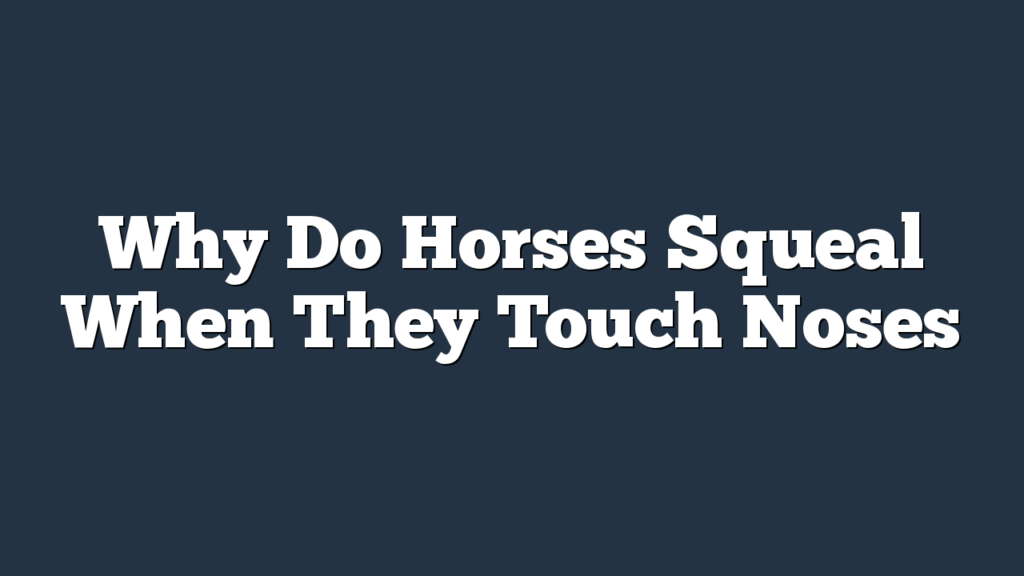Do you ever wonder why horses squeal when they touch noses?
In this article, we’ll delve into the fascinating world of equine social hierarchy and explore the importance of nose-to-nose interactions.
Through body language, horses establish dominance, express interest, and navigate their territory.
We’ll also discuss the role of scent, individual personality, and environmental factors.
By understanding these dynamics, you’ll gain valuable insights on managing nose-to-nose interactions with these majestic creatures.
Understanding Equine Social Hierarchy
To understand equine social hierarchy, it’s important to observe the interactions between horses within a group. Horses are highly social animals and form strong bonds with other members of their herd. Social bonding plays a crucial role in establishing a hierarchy and maintaining order within the group.
Horses communicate through a variety of non-verbal cues, which helps them establish their position in the social hierarchy. These cues include body language, facial expressions, and vocalizations. By observing these interactions, you can gain insights into the dynamics of the group and the relationships between individual horses.
One common behavior that horses engage in to reinforce social bonds is mutual grooming. This is when horses use their teeth to scratch each other’s bodies, particularly in hard-to-reach areas. Mutual grooming not only helps to strengthen social bonds but also provides a form of relaxation and stress relief for the horses involved.
Another important aspect of equine social hierarchy is the establishment of a leader or dominant horse. The dominant horse is typically the one who controls access to resources such as food, water, and shelter. Other horses within the group will often defer to the dominant horse and follow its lead.
Importance of Nose-to-Nose Interactions
Nose-to-nose interactions between horses serve several important purposes.
Firstly, they help to strengthen the bond between individuals, fostering a sense of companionship and trust.
Secondly, these interactions allow horses to communicate with one another, using subtle body language and facial expressions to convey their intentions and emotions.
Lastly, nose-to-nose interactions play a crucial role in establishing social hierarchy within a group, as horses use these encounters to assert dominance and establish their place within the herd.
Bonding Through Nose-To-Nose
When bonding with horses, engaging in frequent nose-to-nose interactions is vital for establishing a strong connection. Mutual grooming and other bonding activities play a significant role in building trust and forming a deep bond between you and your horse.
By allowing your horse to touch noses with you, you’re creating a safe and intimate space where communication can take place. This physical contact releases oxytocin, also known as the ‘bonding hormone,’ which fosters feelings of affection and attachment.
Nose-to-nose interactions also provide an opportunity for your horse to explore your scent, familiarizing themselves with your presence. This helps them feel more comfortable and secure in your company, strengthening your relationship and ultimately enhancing your overall partnership with your horse.
Communication and Socialization
Engaging in frequent nose-to-nose interactions with your horse is essential for communication and socialization, as it allows for the establishment of a strong bond and the development of trust. Horse behavior relies heavily on nonverbal communication, and nose-to-nose interactions play a crucial role in this process.
When horses touch noses, they exchange important information through scent and body language. This intimate contact helps them understand each other’s intentions, emotions, and social status. It also promotes social bonding within a herd or between a horse and its human companion.
Establishing Hierarchy and Trust
By touching noses with your horse, you establish hierarchy and trust, reinforcing your position as a trusted and respected member of their social group. This nose-to-nose interaction is crucial for bonding and trust building between you and your horse.
Through non-verbal communication, horses can convey their intentions, emotions, and establish their rank within the herd. Here’s why nose-to-nose interactions are important:
- Bonding and Trust Building:
- Touching noses allows horses to exchange scents, which helps them recognize each other and form a bond based on familiarity.
- It creates a sense of connection and closeness, strengthening the trust between you and your horse.
- Non-Verbal Communication:
- Nose-to-nose interactions enable horses to communicate through body language, such as softening or stiffening their posture, to convey their intentions and establish their dominance or submission.
- It allows you to understand your horse’s emotions and intentions, facilitating effective communication and building a stronger relationship based on mutual respect and trust.
Communication Through Body Language
To understand communication through body language, observe how horses use subtle movements and gestures to convey their intentions and emotions. Horses are highly perceptive animals and rely heavily on non-verbal communication to express themselves. They utilize a combination of facial expressions and body postures to communicate with other horses, as well as humans.
One of the most important aspects of horse body language is their facial expressions. Just like humans, horses can convey a wide range of emotions through their facial expressions. They may show signs of fear or alertness by widening their eyes and raising their ears. Conversely, a relaxed and content horse may have half-closed eyes and drooping ears.
Additionally, horses communicate through various body postures. For example, a horse that is feeling dominant or assertive may hold its head high, puff out its chest, and square its shoulders. On the other hand, a submissive or fearful horse may lower its head, tuck its tail, and try to make itself appear smaller.
By paying close attention to these subtle cues, you can better understand a horse’s intentions and emotions. This understanding is crucial for effective communication and building a strong bond with these magnificent creatures.
| Facial Expressions | Body Postures |
|---|---|
| Wide eyes and raised ears – fear or alertness | High head, puffed chest, and squared shoulders – dominance or assertiveness |
| Half-closed eyes and drooping ears – relaxation and contentment | Lowered head, tucked tail, and small appearance – submissiveness or fear |
Establishing Dominance and Territory
When horses touch noses, they often squeal to establish dominance and assert their territory. This behavior is a way for horses to communicate their status and boundaries to other horses. Here are some reasons why horses engage in dominance signals and territorial disputes:
- Establishing social hierarchy: By squealing when they touch noses, horses are signaling their dominance over other horses. This helps establish a clear social hierarchy within the group, ensuring that each horse knows its place and can avoid unnecessary conflicts.
- Defending resources: Horses are highly territorial animals, and they use squealing as a way to defend their resources, such as food, water, and shelter. By asserting their dominance, they’re sending a message to other horses that those resources belong to them and shouldn’t be challenged.
- Maintaining order and safety: Dominance signals and territorial disputes help maintain order within a herd. By establishing clear boundaries and hierarchies, horses can reduce aggression and create a safer environment for all members of the group.
Expressing Interest or Attraction
When horses touch noses, they may also squeal as a way of expressing their interest or attraction towards another horse. It’s their way of saying, ‘Hey, I’m interested in you!’ or ‘You caught my attention!’ This behavior is a form of non-verbal communication that horses use to express their curiosity and attraction towards each other.
Horses are highly social animals, and they rely on non-verbal cues to communicate with one another. Touching noses is a common behavior among horses, and it allows them to establish connections and bonds with other horses in their herd. When a horse squeals while touching noses, it can indicate that they’re interested in the other horse and want to initiate a social interaction.
This squealing behavior can also be observed during courtship rituals between male and female horses. When a stallion is attracted to a mare, he may approach her and touch noses. The stallion may then squeal as a way of expressing his interest and desire to mate with her.
Signaling Discomfort or Aggression
If a horse feels uncomfortable or threatened when touching noses with another horse, it may squeal as a way of signaling its discomfort or aggression. Understanding horse behavior and their nonverbal communication is essential to deciphering the meaning behind this behavior. Here are some key points to consider:
- Understanding horse behavior:
- Horses are highly social animals and have a complex communication system.
- They use various body language cues, such as facial expressions, postures, and vocalizations, to convey their emotions and intentions.
- Squealing is one of the vocalizations horses use to communicate their discomfort or aggression.
- Nonverbal communication:
- Horses rely heavily on nonverbal cues to interact with each other.
- Touching noses is a common greeting behavior among horses, but it can also be a source of tension or conflict.
- When a horse squeals during nose-to-nose contact, it’s often a warning sign that it’s feeling uncomfortable or displaying aggression towards the other horse.
Exploring the Role of Scent
Exploring the Role of Scent, you can understand the significance of olfactory cues in the behavior of horses. Scent recognition plays a crucial role in how horses communicate with each other. Horses have an incredible ability to detect and interpret scents, using their highly developed sense of smell. They rely on olfactory communication to convey information and establish social bonds.
Horses use scent recognition to identify familiar individuals, distinguish between friend and foe, and establish dominance within a group. When two horses touch noses, they’re engaging in a behavior known as ‘olfactory investigation.’ This behavior allows them to exchange scents and gather information about each other. By sniffing each other’s breath and body odor, horses can gather important information about the other horse’s age, sex, reproductive status, and overall health.
Olfactory communication also plays a role in the formation and maintenance of social bonds among horses. The exchange of scents during nose-to-nose contact helps to build familiarity and trust between individuals. It can also serve as a form of reassurance and comfort, especially in stressful situations.
Impact of Individual Personality and Temperament
As you delve deeper into the behavior of horses and their interaction through scent recognition, it becomes evident that individual personality and temperament play a significant role in their response when they squeal upon touching noses.
Horses, like humans, have unique personalities and temperaments that shape their behavior and social dynamics. Here are some key points to consider:
- Individual Behavior: Horses, just like people, have their own unique traits and tendencies. Some horses may be more dominant and assertive, while others may be more submissive and cautious. These individual differences can influence how horses react when they come into contact with one another.
- Temperament and Social Dynamics: The temperament of a horse, which refers to their inherent emotional and behavioral traits, can greatly impact their social interactions. A horse with a more excitable and reactive temperament may be more prone to squealing when they touch noses, while a calm and laid-back horse may react differently.
- Influence of Past Experiences: Horses, like any other animal, are shaped by their past experiences. If a horse has had negative encounters or experiences in the past, they may be more likely to squeal or react defensively when they come into close contact with another horse.
Understanding the individual behavior, temperament, and influence of past experiences is crucial in unraveling the mystery behind why horses squeal when they touch noses. By considering these factors, we can gain a deeper insight into the complex social dynamics of these magnificent creatures.
Environmental Factors and Contextual Influences
Now let’s explore how environmental factors and contextual influences contribute to horses squealing when they touch noses.
One key factor is the social hierarchy impact, as horses use vocalizations to establish dominance and maintain order within their herd.
Additionally, territory and dominance cues play a role, as horses may squeal when they feel their personal space is being invaded or when asserting their dominance.
Lastly, emotional and communication cues are important in understanding why horses squeal, as they may express fear, excitement, or discomfort through vocalizations.
Social Hierarchy Impact
When horses touch noses, their squealing is often influenced by the social hierarchy and the environmental factors surrounding them. Understanding the impact of social hierarchy dynamics on herd dynamics is essential in deciphering the reasons behind their vocalizations.
Here are two key factors to consider:
- Dominance: Horses establish a social hierarchy within their herd, with one or a few individuals assuming dominant roles. When two horses touch noses, the dominant horse may squeal as a way to assert its dominance and maintain control over the interaction.
- Territory: Horses are highly territorial animals. Squealing when they touch noses can be a way for horses to communicate their territorial boundaries, especially when encountering unfamiliar horses or trespassers in their space.
Territory and Dominance Cues
Consider the territorial and dominance cues that influence horses when they touch noses.
Understanding horse behavior is crucial in comprehending why they exhibit certain actions when interacting with each other. When horses touch noses, they aren’t only engaging in a physical interaction, but they’re also establishing social boundaries.
This behavior is a way for horses to communicate and assert their dominance or submission within their herd. By touching noses, horses can gather information about each other’s scent, which helps them establish familiarity and hierarchy.
Environmental factors and contextual influences play a significant role in these interactions. For example, horses may be more territorial and assertive when defending their feeding areas or when meeting unfamiliar horses.
These cues and influences shape the dynamics of horse social interactions and help maintain order within the herd.
Emotional and Communication Cues
To understand why horses squeal when they touch noses, it’s important to recognize the emotional and communication cues that are influenced by environmental factors and contextual influences. Horses are highly social animals and form strong emotional bonds with each other. When they touch noses, it’s a way for them to establish and strengthen these bonds. Through this physical contact, horses can convey various non-verbal messages to one another.
Here are some of the emotional and communication cues that horses may exhibit during nose-touching:
- Mutual grooming: Horses use this behavior to bond and show affection towards each other. It helps in establishing trust and strengthening social connections.
- Establishing hierarchy: Nose-touching can also be a way for horses to determine their social rank within a group. It’s a form of non-verbal communication that helps maintain order and reduce conflicts.
Tips for Managing Nose-to-Nose Interactions
Establish clear boundaries and assert your authority when managing nose-to-nose interactions with horses. Managing boundaries is crucial to preventing conflicts and ensuring the safety of both you and the horse. When introducing two horses to each other, establish a designated space where they can interact safely. This can be a round pen or a securely fenced area. By setting clear boundaries, you establish your role as the leader and prevent any potential aggression or dominance issues between the horses.
When managing nose-to-nose interactions, it’s important to pay attention to the body language of both horses. Look for signs of tension, such as pinned ears, raised tails, or a stiff posture. If you notice any of these signs, intervene immediately and separate the horses. It’s better to prevent a conflict than to allow it to escalate.
Another tip for managing nose-to-nose interactions is to introduce horses gradually. Start with short, supervised interactions, gradually increasing the duration as they become more comfortable with each other. This gradual introduction allows them to establish a hierarchy and reduces the likelihood of aggressive behavior.
Remember to always remain calm and assertive when managing nose-to-nose interactions. Horses can sense your emotions, and if you’re anxious or fearful, it can increase the chances of a negative interaction. By establishing clear boundaries and asserting your authority, you can ensure a safe and harmonious interaction between horses.
Frequently Asked Questions
How Long Do Horses Typically Engage in Nose-To-Nose Interactions?
Horses of different breeds engage in nose-to-nose interactions for varying durations. The length of these interactions is influenced by factors such as familiarity, social hierarchy, and the presence of potential threats.
What Are Some Common Misconceptions About Horse Squealing During Nose-To-Nose Interactions?
Common misconceptions about horse squealing during nose-to-nose interactions include thinking it’s always aggressive. However, horses use various vocalizations to communicate, such as squealing, which can also express excitement, playfulness, or even fear.
How Does the Age of a Horse Affect Their Behavior During Nose-To-Nose Interactions?
When horses touch noses, their behavior can be influenced by their age. Younger horses may be more playful and energetic, while older horses may be more cautious and reserved. The size and gender of a horse can also affect their behavior during nose-to-nose interactions.
Are There Any Specific Breeds of Horses That Are More Likely to Squeal During Nose-To-Nose Interactions?
Some horses, regardless of breed, may exhibit squealing behavior during nose-to-nose interactions. This behavior is not specific to certain breeds but can be influenced by individual temperament, social dynamics, and communication styles.
Can Horses Communicate Other Emotions or Messages Through Their Noses Besides Squealing?
Horses can communicate various emotions and messages through nose-to-nose interactions. They use it for bonding, but also for dominance displays. Squealing is just one way they express themselves in these situations.
Conclusion
In conclusion, horses squeal when they touch noses as a means of communication. This behavior helps them establish their social hierarchy, express their dominance or attraction, and explore their surroundings through scent.
Factors such as personality, temperament, and the environment also play a role in these interactions. Understanding and managing nose-to-nose interactions can contribute to better horse handling and overall equine well-being.



